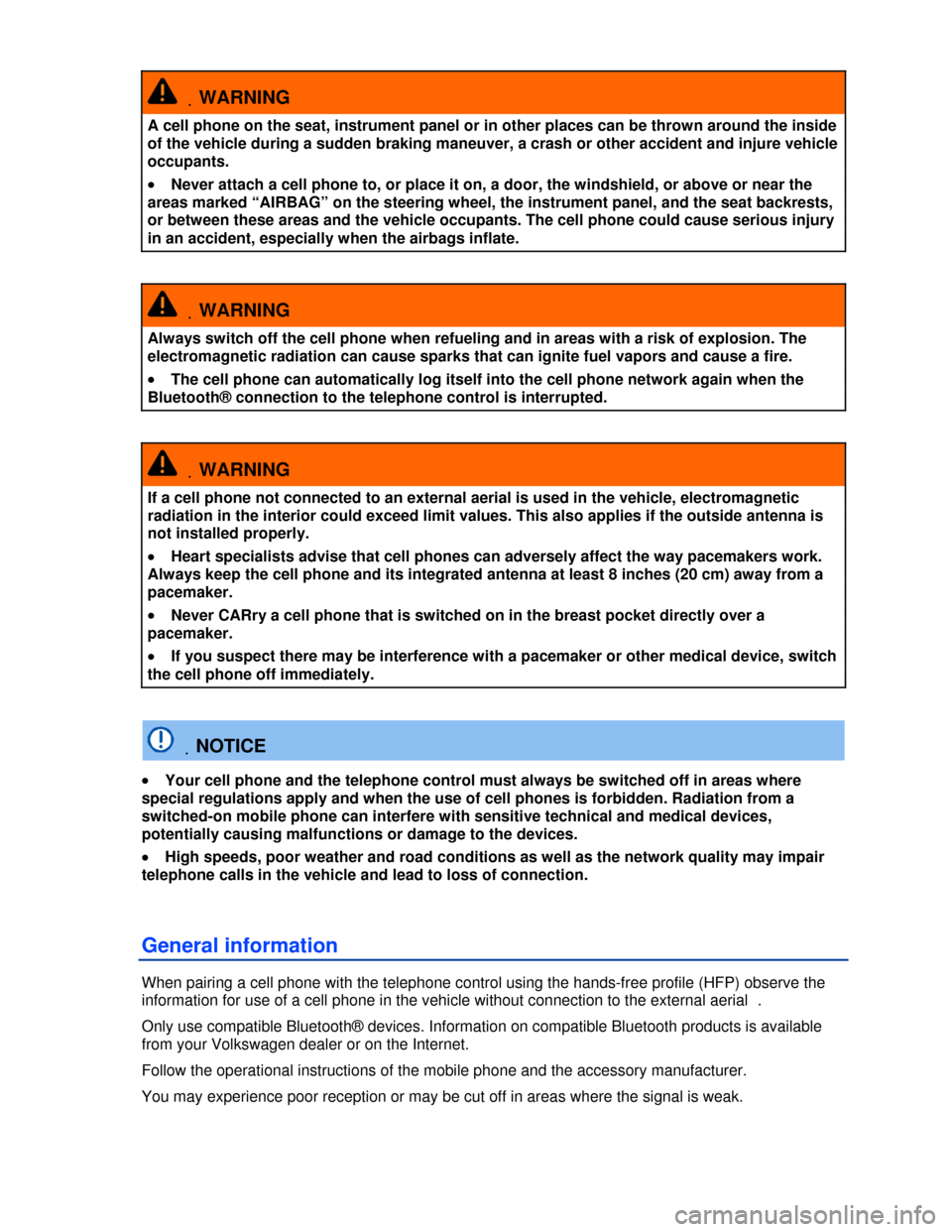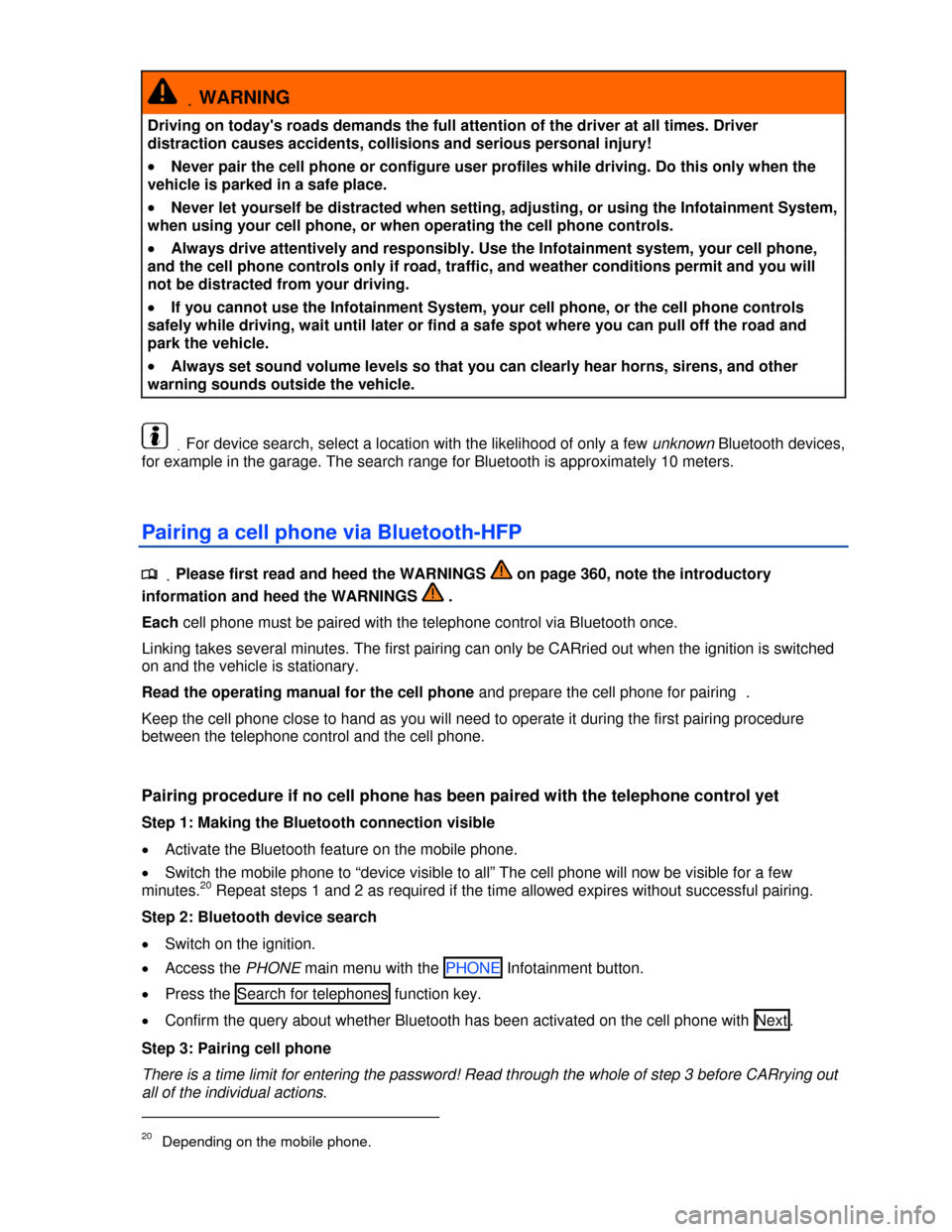Page 293 of 440

.WARNING
A cell phone on the seat, instrument panel or in other places can be thrown around the inside
of the vehicle during a sudden braking maneuver, a crash or other accident and injure vehicle
occupants.
�x Never attach a cell phone to, or place it on, a door, the windshield, or above or near the
areas marked “AIRBAG” on the steering wheel, the instrument panel, and the seat backrests,
or between these areas and the vehicle occupants. The cell phone could cause serious injury
in an accident, especially when the airbags inflate.
.WARNING
Always switch off the cell phone when refueling and in areas with a risk of explosion. The
electromagnetic radiation can cause sparks that can ignite fuel vapors and cause a fire.
�x The cell phone can automatically log itself into the cell phone network again when the
Bluetooth® connection to the telephone control is interrupted.
.WARNING
If a cell phone not connected to an external aerial is used in the vehicle, electromagnetic
radiation in the interior could exceed limit values. This also applies if the outside antenna is
not installed properly.
�x Heart specialists advise that cell phones can adversely affect the way pacemakers work.
Always keep the cell phone and its integrated antenna at least 8 inches (20 cm) away from a
pacemaker.
�x Never CARry a cell phone that is switched on in the breast pocket directly over a
pacemaker.
�x If you suspect there may be interference with a pacemaker or other medical device, switch
the cell phone off immediately.
.NOTICE
�x Your cell phone and the telephone control must always be switched off in areas where
special regulations apply and when the use of cell phones is forbidden. Radiation from a
switched-on mobile phone can interfere with sensitive technical and medical devices,
potentially causing malfunctions or damage to the devices.
�x High speeds, poor weather and road conditions as well as the network quality may impair
telephone calls in the vehicle and lead to loss of connection.
General information
When pairing a cell phone with the telephone control using the hands-free profile (HFP) observe the
information for use of a cell phone in the vehicle without connection to the external aerial .
Only use compatible Bluetooth® devices. Information on compatible Bluetooth products is available
from your Volkswagen dealer or on the Internet.
Follow the operational instructions of the mobile phone and the accessory manufacturer.
You may experience poor reception or may be cut off in areas where the signal is weak.
Page 296 of 440

via a Bluetooth connection. The cell phone logs itself out of the GSM network and logs into the
telephone control using the data from the “borrowed” SIM CARd. The telephone is then controlled
exclusively via the controls in the vehicle. The mobile phone goes into standby mode. This Bluetooth
profile allows all telephone control functions and the exterior aerial to be used to the full.
�x Bluetooth Hands-Free Profile (HFP): If a cell phone is connected via HFP to the telephone
control, you can make calls wireless via the hands-free system. Many other telephone control
functions are not available. The vehicle's exterior aerial can thus not be used.
�x Advanced Audio Distribution Profile (A2DP): Bluetooth profile for transferring audio signals .
.Volkswagen recommends pairing a cell phone with the telephone control via Bluetooth-rSAP in
order to use all telephone control functions.
Components of the telephone control
Fig. 222 3 button module in the roof: Controls for the telephone control.
.�
Page 298 of 440
.If the device is connected to the telephone control via A2DP, no other devices can be paired.
The Bluetooth visibility of the telephone control deactivated for the duration of the active A2DP
connection. This is not a fault in the telephone control. In order to pair further devices, deactivate the
Bluetooth audio (A2DP) feature in Telephone settings and Bluetooth settings and activate it again
after completing the pairing.
Adjusting the volume
.�
Page 301 of 440

.WARNING
Driving on today's roads demands the full attention of the driver at all times. Driver
distraction causes accidents, collisions and serious personal injury!
�x Never pair the cell phone or configure user profiles while driving. Do this only when the
vehicle is parked in a safe place.
�x Never let yourself be distracted when setting, adjusting, or using the Infotainment System,
when using your cell phone, or when operating the cell phone controls.
�x Always drive attentively and responsibly. Use the Infotainment system, your cell phone,
and the cell phone controls only if road, traffic, and weather conditions permit and you will
not be distracted from your driving.
�x If you cannot use the Infotainment System, your cell phone, or the cell phone controls
safely while driving, wait until later or find a safe spot where you can pull off the road and
park the vehicle.
�x Always set sound volume levels so that you can clearly hear horns, sirens, and other
warning sounds outside the vehicle.
.For device search, select a location with the likelihood of only a few unknown Bluetooth devices,
for example in the garage. The search range for Bluetooth is approximately 10 meters.
Pairing a cell phone via Bluetooth-HFP
.�
Page 302 of 440

�x If necessary activate “wait for incoming Bluetooth connections”.
�x Hold the cell phone in your hand ready to enter the password within the time limit.
�x Select the cell phone from the device list in the vehicle by pressing the corresponding function key.
�x Select the required pairing protocol below the cell phone found.
�x On the cell phone, confirm the connection queries from the vehicle if required.
�x Confirm the 4-digit password displayed on the Infotainment System screen.
�x Enter the password on the cell phone within 30 seconds.26
�x Confirm password entry.
�x If necessary, confirm further queries on the mobile phone.
Pairing procedure if a cell phone has already been paired with the telephone control
�x Set the Bluetooth connection to visible on the cell phone , step 1.
�x Switch on the ignition.
�x Access the SETUP main menu with the SETUP Infotainment button.
�x Press the Telephone function key.
�x Press the Bluetooth settings function key.
�x In the Bluetooth settings menu, press the Search for Bluetooth devices function key.
�x If necessary, confirm the query about whether Bluetooth has been activated on the cell phone with
Next .
�x CARry out pairing as described , step 3.
Failed pairing
There is no limit on the number of attempts to pair the device with the telephone control.
Linking will not be successful if the password input time limit is exceeded or if the PIN code is entered
incorrectly.
Restart linking if the process fails despite correct entries.
Copying telephone directory to the telephone control
Once pairing has been successfully completed, the telephone directory entries from the cell phone26
are loaded automatically into the data memory of the telephone control Depending on the number of
entries copied, the process can take several minutes.
The telephone directory memory of the telephone control is limited to 5000 entries. Each user profile
can be assigned a maximum of 2000 entries as well as 100 user-created or edited entries.
Automatic connection to a paired cell phone
.�